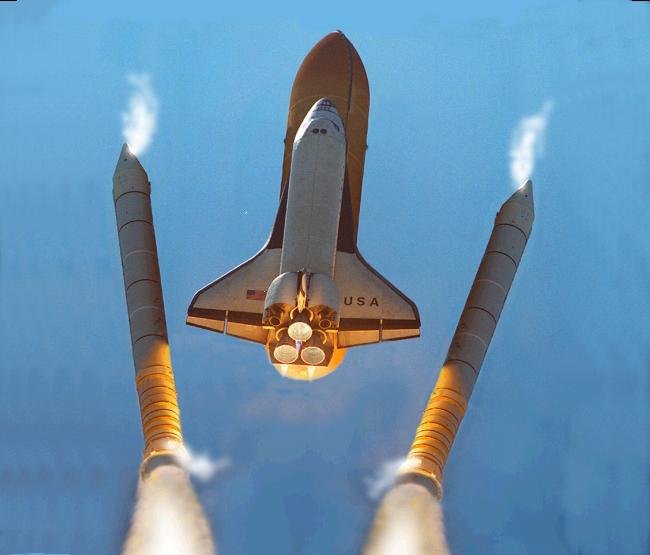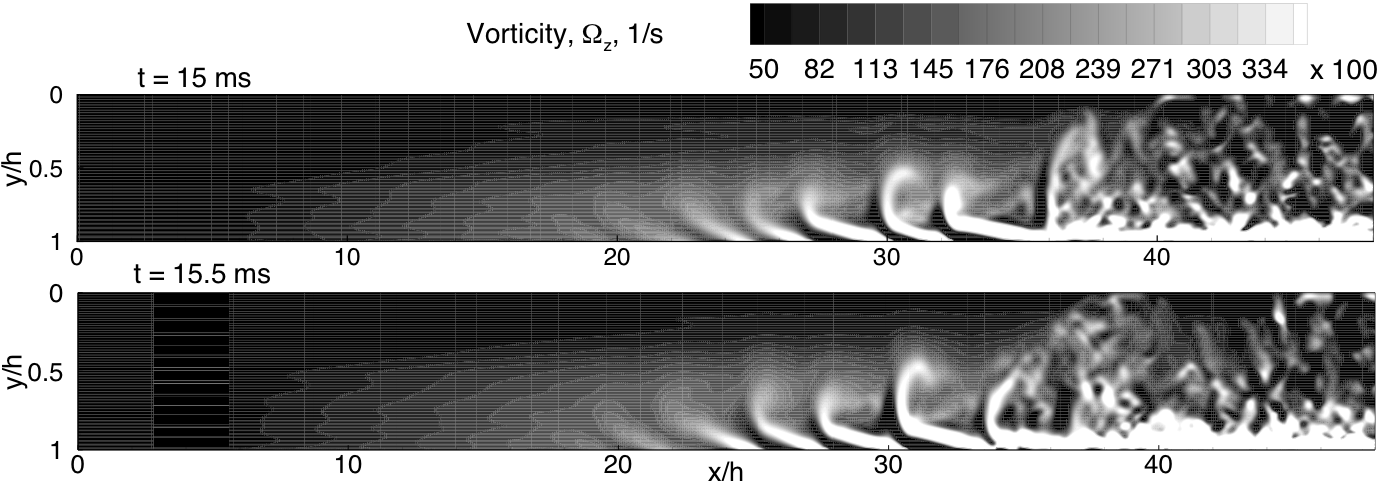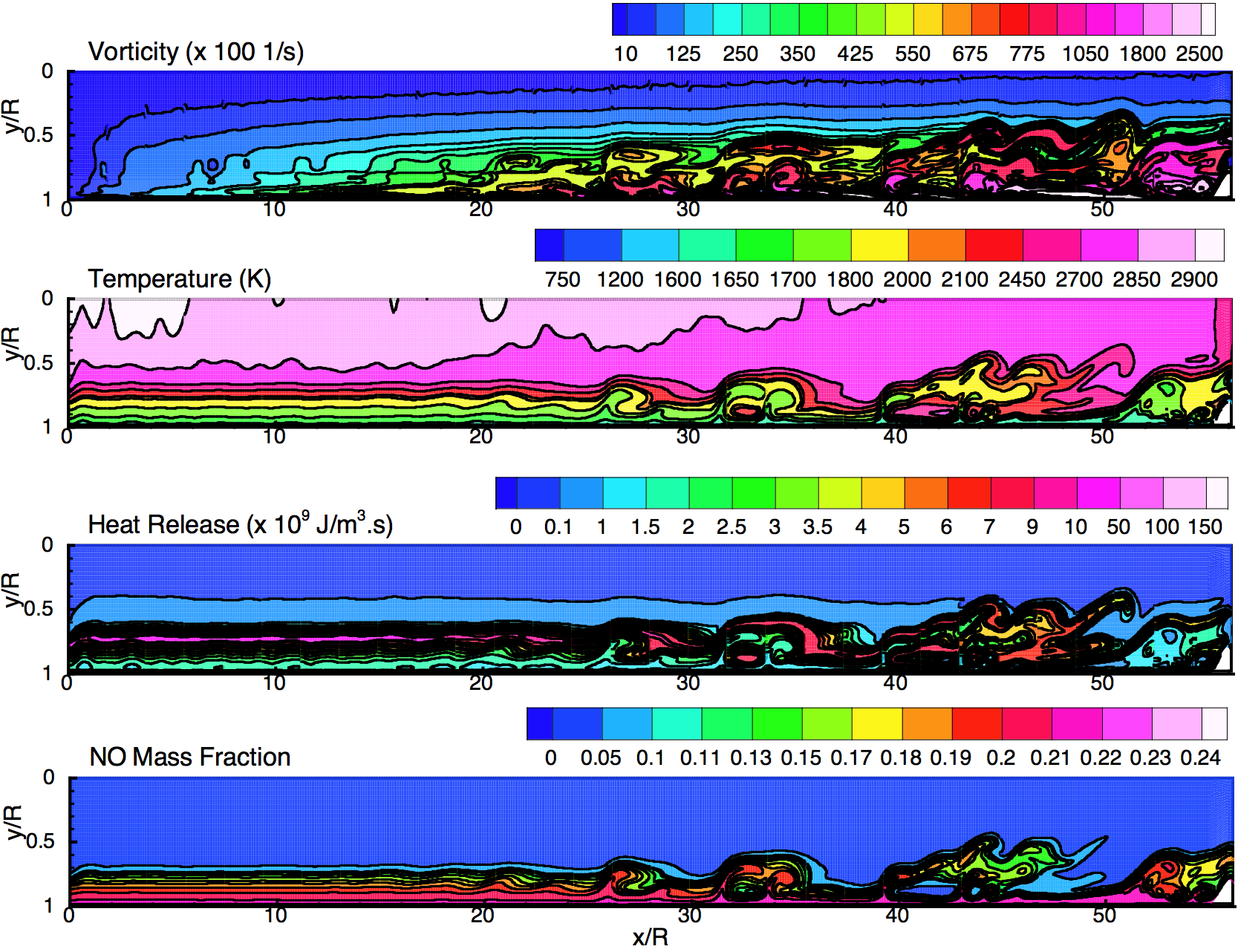|

Large Eddy Simulation of Internal Flow and Combustion Dynamics in a Solid Propellant Rocket Motor
 The increasing demand for enhanced thrusts and range of missiles for military applications has led to increase in the operating pressures for solid rocket motors and boosters. This increases the burning-rate of the solid propellant and also the temperatures reached within the combustion chamber. The increased mass-flow rate and turbulence near the nozzle region may lead to erosive burning of the propellant and cause early burnout and nozzle erosion, and drastically affect the performance and structural stability of the missile. In addition, the space-time characteristics of pressure fluctuations within the combustion chamber is a matter of serious concern. Use of composite propellants at high pressures gives extremely thin non-premixed flame regions where a large amount of heat is released through exothermic reactions. Only a small part of this energy is sufficient to drive unsteady motions and self-sustained pressure fluctuations over a broad range of frequencies; a phenomenon commonly known as combustion instabilities. Fundamental research into understanding, bypassing, and controlling the mechanisms responsible for initiation of unstable combustion and nozzle erosion is a crucial step towards minimizing delays and costs of solving these problems during the design of new-generation missiles. The increasing demand for enhanced thrusts and range of missiles for military applications has led to increase in the operating pressures for solid rocket motors and boosters. This increases the burning-rate of the solid propellant and also the temperatures reached within the combustion chamber. The increased mass-flow rate and turbulence near the nozzle region may lead to erosive burning of the propellant and cause early burnout and nozzle erosion, and drastically affect the performance and structural stability of the missile. In addition, the space-time characteristics of pressure fluctuations within the combustion chamber is a matter of serious concern. Use of composite propellants at high pressures gives extremely thin non-premixed flame regions where a large amount of heat is released through exothermic reactions. Only a small part of this energy is sufficient to drive unsteady motions and self-sustained pressure fluctuations over a broad range of frequencies; a phenomenon commonly known as combustion instabilities. Fundamental research into understanding, bypassing, and controlling the mechanisms responsible for initiation of unstable combustion and nozzle erosion is a crucial step towards minimizing delays and costs of solving these problems during the design of new-generation missiles.
This work was part of Dr. Apte's doctoral thesis at PennState.

Temporal evolution of out-of-plane vorticity in a nozzleless rocket motor with sidewall injection showing laminar regime in the upstream, transitional region in the mid-section, and fully turbulent flow further downstream (Apte and Yang, JFM 2003). The figure below shows vortcity snaps in the x-z plane clearly showing sudden transition to turbulence (Apte and Yang, JFM, 2003).
This research on solid rocket motors (SRM) was directed toward establishment of clear understanding of the interactions between unsteady burning of the solid propellant, gas-phase flame dynamics, thermal and mechanical impact of the ensuing flow on the exit nozzle, and the overall effect o f these interactions on performance of the rocket motor. We performed large eddy simulations (LES) of internal flow dynamics inside the rocket chamber using an all-Mach number finite volume solver capable of simulating compressible reacting flows at transonic conditions. We performed LES of three different flows: (i) an isothermal flow with sidewall injection in a nozzleless rocket motor, (ii) isothermal flow in a nozzleless SRM with imposed planar traveling waves to study transition to turbulence, and (iii) combustion dynamics of a homogeneous propellant solid rocket motor. f these interactions on performance of the rocket motor. We performed large eddy simulations (LES) of internal flow dynamics inside the rocket chamber using an all-Mach number finite volume solver capable of simulating compressible reacting flows at transonic conditions. We performed LES of three different flows: (i) an isothermal flow with sidewall injection in a nozzleless rocket motor, (ii) isothermal flow in a nozzleless SRM with imposed planar traveling waves to study transition to turbulence, and (iii) combustion dynamics of a homogeneous propellant solid rocket motor.
 Our fundamental studies revealed the laminar, transitional, and fully turbulent regimes in a rocket motor. Furthermore it was shown that traveling waves imposed on a stationary flow with sidewall injections can cause early transition and enhanced turbulence levels at certain frequencies. Our LES studies on reacting flows in a rocket motor focused on investigation of the coupling among vortical, acoustic, and entropy waves in a turbulent flow to better understand the combustion instability mechanisms. Our fundamental studies revealed the laminar, transitional, and fully turbulent regimes in a rocket motor. Furthermore it was shown that traveling waves imposed on a stationary flow with sidewall injections can cause early transition and enhanced turbulence levels at certain frequencies. Our LES studies on reacting flows in a rocket motor focused on investigation of the coupling among vortical, acoustic, and entropy waves in a turbulent flow to better understand the combustion instability mechanisms.
Adjacent figure shows internal combustion dynamics in a homogeneous solid propellant rocket motor (Apte and Yang, Combustion and Flame, 2003)
-
Apte, S. V., and Yang, V., 2003, A large-eddy simulation study of transition and flow instability in a porous-walled chamber with mass injection, Journal of Fluid Mechanics, Vol. 477, pp. 215-225. (PDF)
-
Apte, S. V., and Yang, V., 2002, Unsteady flow evolution and combustion dynamics of homogeneous solid propellant in a rocket motor, Combustion and Flame, Vol. 131, pp. 110-131. (PDF)
-
Apte, S.V., and Yang, V., 2002, Unsteady flow evolution in a porous chamber with surface mass injection II: Forced oscillations, AIAA Journal, Vol. 40(22), pp. 244-253. (PDF)
-
Apte, S.V., and Yang, V., 2001, Unsteady flow evolution in a porous chamber with surface mass injection I: Free oscillations, AIAA Journal, Vol. 39(88), pp. 1577-1586. (PDF)
-
Apte, S. V., and Yang, V., 2000, Turbulent flame dynamics of homogeneous solid propellant in a rocket motor, Proceedings of the Combustion Institute, Vol. 28, pp. 903-910. (PDF)
-
Apte S.V., and Yang, V., 2000, Effects of acoustic oscillations on flow development in a simulated nozzleless rocket motor, Solid Propellant Chemistry, Combustion, and Motor Interior Ballistics, AIAA Progress in Astronautics and Aeronautics, Vigor Yang, Thomas Brill, and Wu Zen Ren (Eds.), Vol. 185. (PDF)
-
Roh, T.S., Apte S.V., and Yang, 2000, Combustion Dynamics of Homogeneous Solid Propellants in a Rocket Motor with Acoustic Excitations, Solid Propellant Chemistry, Combustion, and Motor Interior Ballistics, AIAA Progress in Astronautics and Aeronautics, Vigor Yang, Thomas Brill, and Wu Zen Ren (Eds.) Vol. 185. (PDF)
-
Roh, T-S., Apte, S. V., Yang, V., 1998, Transient combustion response of homogeneous solid propellant to acoustic oscillations in rocket motor, Proceedings of the Combustion Institute, Vol. 27, pp. 2333-2341. (PDF)
-
Apte, S.V., 2000, Unsteady flow evolution and combustion dynamics of homogeneous solid propellant in a rocket motor, Ph.D. Thesis, Department of Mechanical and Nuclear Engineering, Pennsylvania State University, University Park, PA. (PDF)
|
|
|
| |
|
©All rights reserved by the Apte Research Group. |

